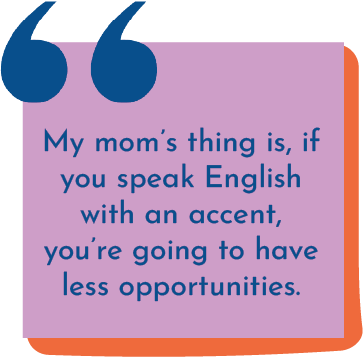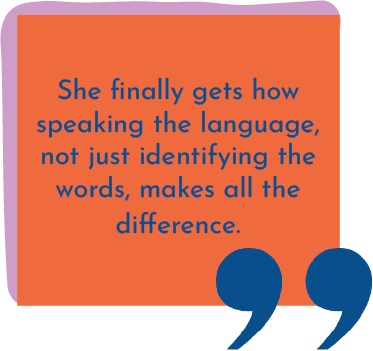Many university students are on their own when it comes to reconnecting with their heritage language
Words by Mariyah Salhia
Visuals by Jes Mason
In a grainy home video, Michelle Belov is just a toddler, running around, playing with her toys and babbling to herself. In perfect Russian, she says, “I’m a princess! I’m queen of the world!” As she watches the old footage of herself, her parents turn to look at her. “See,” they say. “You used to speak Russian.”
Belov, a third-year collaborative nursing student, was in high school the first time she saw proof that she spoke her parents’ mother tongue as a young child.
The memory, now a little bittersweet, is one she could barely wrap her head around; herself, speaking in Russian with no inhibition about what she’s saying, or her accent. Two things that are now constantly on her mind when she thinks about speaking the language.
Although she can read and write fluently in Russian, she decided as a kid that she was going to speak English, something she attributes to her daily consumption of shows on the Treehouse channel and being immersed in English all day at elementary school.
As a teen, due to her inability to speak Russian, Belov felt less and less connected to her heritage. Trying to learn from her parents was too frustrating because of her Westernized accent—her dad was mad at her for giving up on the language and she blames him for his lack of patience.
While census data shows that Canada’s younger population is getting more diverse, it also found that mother tongues are becoming less prevalant in the home.
The 2016 census found that 2.2 million children under the age of 15, or 37.5 per cent of the total population of children, were foreign-born or had at least one foreign‑born parent. If the trend continues, children with an immigrant background could represent between 39 per cent and 49 per cent of the total population of children in 2036.
However, in families with two immigrant parents, 24.4 per cent of these children spoke only English and French at home, compared to just 2.5 per cent of their parents.
The census also found that 60 per cent of immigrants who came to Canada between 2011 and 2016 (excluding Quebec) spoke English most often at home, despite 78.5 per cent of this same group reporting a mother tongue other than English and French.
Guofang Li, a language professor at the University of British Columbia, says university students are among the most likely to try to learn their heritage language in comparison to other age groups.
“A lot of university students come back to their mother tongue because some of them failed to learn when they were young,” she says. “All of a sudden when they come to college, they realize that their cultural heritage is really important.”

Li says that this is often due to being away from family, who for a lot of second-generation students, are their main connection to their heritage.
Learning a language as an adult is never easy though. People are proficient at learning a second language up until the age of 18, according to a 2018 MIT study. However, to achieve the fluency and proficiency of a native speaker, it’s nearly impossible unless you start learning at the age of 10.
The study suggests that this can be caused by biological factors, like changes in the brain’s ability to grow and reorganize, as well as social factors, like leaving your home where the language is spoken or no longer having time to learn because of work and school.
For university students especially, Li says there are other factors that can inhibit the ability to speak a heritage language, like self-consciousness about their Westernized accent, much like what Belov experienced. To acquire a language in its natural accent, some research suggests you have until around the age of 10 to learn it, says Li.
Still, students may be inclined to try and learn the language later in life through more self-guided methods. Language apps like Duolingo, Babbel and Rosetta Stone may seem like the obvious solution due to the marketing of their services as cheap, fast and effective. Duolingo claims that just a few minutes a day can improve your language skills. But unlike recreational learners, there are motivations for heritage speakers outside of just wanting to acquire another language, like wanting to connect with their families and their cultural identity.
Li says that while language learning apps can help with learning the basics of communication, they often neglect the cultural aspects that help people with ethnic identity. The apps also don’t take into account the regional differences that impact language.
Additionally, Li says that the “everything as soon as possible” mindset of younger generations is not conducive to learning a language.
“It’s not as fast as three days or whatever Duolingo says,” says Li. “Language learning isn’t fast for young adults.”
Belov turned to Duolingo in high school when she decided to try learning Russian again. The app mainly focused on reading and grammar; skills which Belov had already mastered. She also found the exercises to be unhelpful—somehow they were simultaneously too easy and too difficult for her to grasp, given they lacked conversational context.
Nonetheless, going to her parents wasn’t an option. The fear of being ridiculed by them for her accent is always lurking in the back of her mind.
“Character development, I guess.”
The inability to pick up the language can lead to a disconnection to cultural identity, or even contribute to the extinction of a young person’s heritage language.
That’s why some Ryerson students are turning to unorthodox and self-guided means of learning their mother tongue—without the help of mainstream language resources or their families.

oing home to the Philippines every few summers to see her mom’s family is something that Gabriella Bunag always looks forward to. Something she’s come to expect from these trips, however, is feeling out of place among her family.
Bunag, a fourth-year business management student studying human resources, is unable to speak Ilonggo, her family’s mother tongue. And while she says that they’re nice to her about it, it does mean that her relatives treat her differently.
Bunag has memories of sitting at the dinner table and laughing because everyone else was, not because she understood the joke. By the time her mom would translate for her, the moment had usually passed. Her family members were always making sure to switch out of Ilonggo to tell her something simple, like the weather that day; she doesn’t even really recall them speaking to her in a language other than English.
“No, no. In Ilonggo please,” she’d tell them the first few times.
“But you won’t be able to understand,” they’d always respond.
Dejectedly, she’d reply, “I guess this is what we’re doing.” After a while, she got tired of asking.
She even remembers some of the maids at the house going out of their way to make sure that everything was always just right for her, like she was a guest at a hotel. Bunag knew she was loved and she was welcome in her family’s home, but she also knew that she was being treated like an outsider because she couldn’t communicate with her family in their language.
Even when they aren’t in the Philippines, Bunag’s mom translates everything from the “hot family goss” to conversations with her grandparents and godson. This works for now, but she knows that her parents won’t always be around to translate.
In the Philippines, there are over 100 different dialects and languages specific to different regions. Ilonggo, Bisaya and Tagalog, the national language of the Philippines, are all spoken by her family members. Despite this being the only way she can communicate with a lot of them, the languages are difficult to grasp because no one ever taught her. Bunag says her parents were never really concerned about her being able to speak any regional tongue until it was too late—something she says a lot of second-generation Filipino kids go through.
She can recall her mom bragging about how her daughter’s reading level was at a high school level when she was just a first-grader. However, she never talked about Bunag trying to learn Ilonggo.
Growing up, Bunag never noticed how her mom had a different accent that she used to speak to her family compared to everyone else until one of her high school friends pointed it out. She didn’t realize it was something her mom did consciously.

“[My mom’s] thing is, if you speak English with an accent, you’re going to have less opportunities,” Bunag says. “So she wanted to make sure that my English was perfect before anything else.”
According to Li, this mindset is often borne from living in predominantly English-speaking areas of Canada, like Ontario. For some families, this means that English is often considered the most important and French takes second place, leaving heritage languages at the bottom.
While Bunag regrets her parents’ decision to not push Ilonggo’s importance in her life, she’s made peace with why they had to.
Her lack of understanding of the language goes farther than her parents though. Her efforts to learn it when she was younger were also unsuccessful.
When she was in grade seven to eight, every weekend, Bunag would walk into her Saturday school Tagalog class. Students aged 5 to 14 would be sitting at their desks and in each lesson, about halfway through, the older students would have to shift their focus from their own work to help the younger ones.
“There were no grade levels,” she says. “So you can imagine how helpful that was.”
This is a problem that a lot of weekend or after-school language classes have, according to Li. She says that heritage language schools often have inconsistent teaching methods, don’t differentiate instruction for second-generation learners and employ volunteers who aren’t trained language teachers. Many kids in those environments are essentially never set up to successfully learn.
A 2019 study from the International Journal of Applied Linguistics & English Literature interviewed students at a weekend Arabic school in New Zealand. The students described feeling dissatisfied with the learning environment. They cited a lack of engaging teaching strategies when compared with mainstream schools; a consequence of low budgets and a lack of resources.
In terms of learning the language individually, most language learning apps don’t even have an option for Bunag to try.
“Duolingo doesn’t have any Filipino languages out of you know, the 170 that we have,” she says. “So we have to search up more, quote-unquote bootleg ones.”
In more recent years, Bunag tried to learn through one of those “bootleg” apps, called Drops. Drops is a game-based app, similar to Duolingo, but more inclusive to Pacific Islanders, with language offerings like Maori, Samoan, Tagalog, Vietnamese and Hawaiian. It also markets fast learning above all else. Much like Bunag’s chaotic Saturday school class, the app only teaches words, not how to have a conversation.
Now, the only way Bunag sees herself successfully learning any of her heritage languages would be to spend a summer doing classes in the Philippines, even though English would still be spoken there sometimes. She feels like in order to truly grasp the languages, she needs to be immersed in a setting where it’s the norm. Much like how her mom used to positively reinforce her accomplishments in English, she needs the same kind of validation in learning her mother tongue.

dmond Xu remembers being excited to visit Taishan County, located in his home province of Guangdong, China. In August of 2019, he embarked on a 17-hour journey to see his family. He’d waited years to be in a place where he could be immersed in his heritage language. He always joked that he couldn’t wait for the day where he could order McDonald’s in Taishanese.
Eager to speak to his family in Taishanese, he knew that hours of leg cramps, uncomfortable seats, layover flights and bus rides would be worth it when he finally reached home.
But when he arrived there, he quickly learned that most of the younger people he met only spoke Mandarin. His younger cousin was one of the only school-aged people he came across who could speak Taishanese.
A common phenomenon he noticed was parents speaking to their kids in Taishanese, only for them to respond in Mandarin.
While many people think that Chinese languages are just different dialects of one another, Xu says that for the most part, they’re entirely different.
Xu explains that a lot of the older members in his community don’t see the value in learning the language, which isn’t a phenomenon that is unique to Taishanese. With the standardization of Mandarin in schools across China, some think that Taishanese and other regional languages will fall out of use in the next 100 years.
“In school, they actually have a policy where you can’t speak any other languages other than Mandarin. So they’re kind of forbidden from talking to their classmates in Taishanese.”

Because the government wants to standardize one language across the country, students don’t get a formal, board-certified education in their regional languages. So to people like Xu’s parents, trying to revive it is pointless for the future, as well as challenging.
“I don’t see it that way,” he says. “I see it as a means of preserving culture.”
After years of listening to his parents and grandparents speak in Taishanese, Xu understood conversational language, but wanted to learn more. When he consulted the internet, he was met with virtually no resources.
But that didn’t stop him.
Initially, he had found two different Taishanese dictionaries online. While it was helpful that they had definitions in Mandarin, Taishanese and English, he realized that they weren’t always consistent with each other due to a lack of standardization. So he started a Discord server with his friend in 2018 to create a place where Taishanese people can be in the presence of each other and talk about Taishanese culture, food, art, language and traditions.
Most importantly, the server is a place where people from his community can hang out and be proud of being Taishanese, something that Xu says isn’t always perpetuated in the Chinese diaspora. He’s heard from some people that they initially came to just be part of a community but ended up staying when they were able to learn things about their culture that they weren’t able to learn elsewhere.
“It was really cool to hear other people talk about the things that I’ve always experienced.”
Xu also helped start Hoisan Sauce, a YouTube channel that’s dedicated to the promotion of Taishanese language, culture and history. Due to the lack of a formal system, Xu created his own Romanization system that he uses in the videos to help others understand the phonetics of the language. Romanization is the conversion of language from a different, often character-based writing system into the Roman script.
Li says that if this Romanization system becomes widely used, it can be a helpful tool for preserving the language, but that it also isn’t the easiest task to achieve.
Regardless, she says that learning a language has countless rewards, and offers this advice, considering we’re only ever only getting older: “It’s never too late. So now’s a good time and this is the best time,” she says. “You just need to keep at it.”

ince Belov’s situation hadn’t changed with her parents, and language learning apps proved to be a disappointment, she looked for other ways she could immerse herself into the Russian language, on her own.
She started small, watching Russian influencers and listening to Russian music. Eventually, they helped her to get more comfortable in speaking the language. Belov says watching Russian YouTubers her age was especially helpful because she’s able to hear the language in a more casual and relatable context, closer to her everyday experiences.
In fact, she’s been revisiting poems that her dad used to read to her as she was snuggled in bed as a little girl. Reading them now, she finally gets how speaking the language, not just identifying the words, makes all the difference.
A few years ago, once she finally built up a level of proficiency and comfort from practicing, she nervously guided her parents to the living room. She made sure the television volume was low and had them sit down on the couch in front of her. She took a look at herself in the reflection of the television set and breathed deeply.
“Hi, how are you? The weather is nice today,” she said in Russian, her parents’ mother tongue. She followed that quickly with: “Are you proud of me?”











Leave a Reply